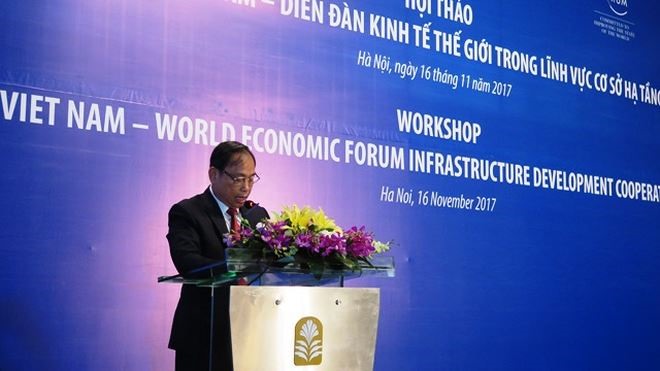【croatia vs thổ nhĩ kỳ】PPPs can work with better grasp of risks: experts
发布时间:2025-01-10 01:57:11 来源:88Point 作者:World Cup
PPPs can work with better grasp of risks: experts
November 17,croatia vs thổ nhĩ kỳ 2017 - 09:51A working group between the Vietnamese Government and the World Economic Forum (WEF) will be established to help the country solve its issues regarding infrastructure development in the long-term, especially in terms of private public partnership in infrastructure.
 |
| Deputy Minister of Planning and Investment (MPI) Nguyễn Văn Hiếu said at a conference on Thursday. — Photo tinnhanhchungkhoan.vn |
HÀ NỘI — The public-private-partnership investment model as a solution for Việt Nam’s long-term infrastructure development can only work with all stakeholders fully understanding their roles and the risks involved, experts said at a conference on Thursday.
Deputy Minister of Planning and Investment (MPI) Nguyễn Văn Hiếu said at the conference that despite the country’s internationally recognised advancements in recent years, there were signs of a “slowdown and stagnant productivity,” and a significant factor in this is the “low quality of infrastructure.”
He said that a working group of officials from the Vietnamese Government and the World Economic Forum (WEF) will be formed to address long-term infrastructure development issues that the country is facing.
The group will focus particularly on solutions via public private partnerships, he added.
Infrastructure had been identified by the Vietnamese Government as one of three pillars of its growth strategy for the 2011-20 period, alongside institutional reforms and human resources development. However, as in other developing countries, the enormous investment required is beyond the capacity of the State Budget.
“The capital needed for infrastructure development until 2030 has been estimated at VNĐ3.3 quadrillion (US$145.3 trillion), which has not included costs for high-speed railways, airways, and waterway development. However, the National Assembly has only approved a mid-term investment plan of VNĐ150 trillion ($6.6 trillion), a small fraction,” he said.
Nguyễn Văn Viện, deputy director of the Việt Nam Institute for Development Strategy, said that the infrastructure system in Việt Nam “has taken shape,” with a traffic system comprising 364,000km of roads, 745km of highways, 23,000km of national roads, 32 seaports and several waterways. However, most of them are of low quality, “the energy infrastructure relies heavily on fossil fuels… and urban infrastructure is lacking, evidenced by rampant flooding, congestion, and the lack of connectivity."
“Similar deficiencies can also be witnessed in other areas such as healthcare and education infrastructure,” Viện said.
Alex Wong, head of Global Challenge Partnerships and member of WEF Executive Committee, stressed that as Việt Nam has made it to the group of middle-income countries, the abundant foreign development assistance it once enjoyed is no longer a dependent source, therefore, Việt Nam needs to diversify its investment forms, and public-private partnership has become a necessity.
Wong said PPP was “a long marriage” and that the Government needs to understand that private sector involvement is not “free money.” PPP’s potentials can only be fully realised if each party is fully aware of its share of the risks and responsibilities, he added.
Wong said the conference was the first brainstorming session between stakeholders – private businesses, the Government, academia and civil society – to share best practices and converse frankly about PPP challenges in Việt Nam.
Organised into two parts, the conference discussed the direction of co-operation between the Vietnamese Government and WEF, the 2017-18 agenda, the secretariat and operations of the infrastructure working group, as well sustainable development investment partnership (SDIP).
In a meeting with WEF Managing Director Phillip Rosler in Netherlands last July, Prime Minister Nguyễn Xuân Phúc has asked the forum to assist Việt Nam in consolidating mechanisms and policies to attract investment in infrastructure from both domestic and foreign businesses.
The request took the form of a seven-agenda co-operation agreement on long-term investment, infrastructure and development between two sides that targets “future-proofing” the Vietnamese economy. — VNS
- 上一篇:Gần 50% doanh thu quảng cáo “chảy vào túi” các nền tảng xuyên biên giới
- 下一篇:Giá xăng dầu đồng loạt tăng trong kỳ điều hành ngày 2/1
相关文章
- VNeID sẽ phục vụ tốt hơn khi sửa đổi luật và hoàn thiện thêm tính năng
- Hải quan TP.HCM: Bàn giải pháp thu ngân sách trong những tháng cuối năm
- MU ‘né’ kỷ lục buồn 49 năm ở ra quân đấu Brighton
- Đi chợ bất đắc dĩ
- 11 sản phẩm đáng mong đợi nhất của Apple ra mắt trong năm nay
- SCIC bán hết 100% số cổ phần chào bán tại Công ty Vắc xin và Sinh phẩm Nha Trang
- U19 Việt Nam hạ U19 Malaysia phút cuối, HLV Đinh Thế Nam nói gì?
- Triển lãm 36 tác phẩm mỹ thuật của tác giả trẻ
- Galaxy Note 7 chưa bị thu hồi sẽ bị khóa từ xa
- MU vs Brentford: MU và thảm họa Erik ten Hag
- Không thể quy trách nhiệm Bộ Công Thương phá vỡ quy hoạch điện mặt trời!
- Borna Coric loại Nadal lập kỳ tích vô địch Cincinnati Open
- Quan Văn Chuẩn chờ cơ hội được bắt chính ở CLB Hà Nội
- Phái sinh: Sự giằng co sẽ tăng mạnh hơn ở vùng giá cao
- Đề xuất phạt người bắt ốc trong vườn quốc gia Côn Đảo hơn 137 triệu đồng
- Chính thức thành lập Bảo tàng Gốm cổ Sông Hương
- Huế có một “Cặp đôi hoàn hảo” như thế
- Phấn đấu nâng kim ngạch XNK Việt Nam
- Ngày 3/1: Giá thép Trung Quốc dứt đà tăng, nhập khẩu quặng sắt dự báo cao kỷ lục
- Lịch thi đấu bóng đá Ngoại Hạng Anh 2022/2023 vòng 2
随便看看
- Copyright © 2025 Powered by 【croatia vs thổ nhĩ kỳ】PPPs can work with better grasp of risks: experts,88Point sitemap
